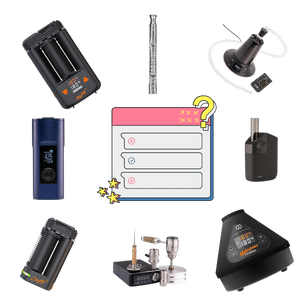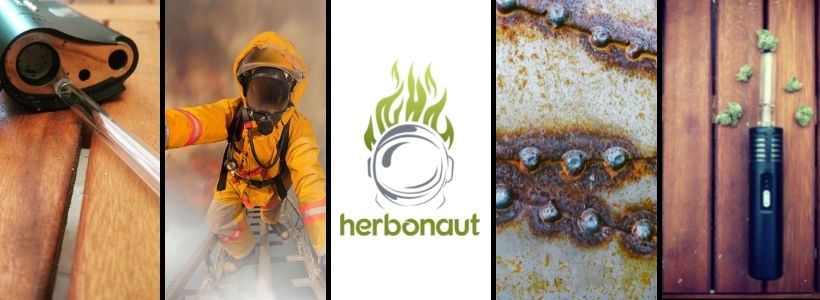
When it comes to vaping and vaporizer safety…
The number ONE question that’s on the mind of us health-conscious cannabis-connoisseurs is the following:
Are vaporizers safe?
The answer to this question might come as a surprise …
No! Vaporizers are not always safe.
Even though vaporizing in and of itself is a less harmful option health-wise than smoking (1), this only holds IF you use the right vaporizer.
It is possible to not only negate all the harm-reducing effects associated with vaporizers if you (accidentally) combust with your vaporizer …
But it gets worse:
You can damage your health with heavy metal poisoning or inhale plastic micro-particles if you get the wrong vaporizer.
Unfortunately not every manufacturer has your health as a top priority. Short-term profits sometimes trump ethics, also in the vaporizer industry.
But after reading today’s post, worries about putting your health at risk with a dangerous vaporizer will be something of the past.
I’m going to exactly show which parts of a vaporizer have the potential to put you in a hospital bed and how you can avoid the dangerous vaporizers.
But also:
Where to get the safest and healthiest vaporizers.
Important note: If want to know what health risks are associated with ‘e-cig’ type of vapes, like vape mods, pod-systems, and e-liquids, please read e-cig vaping health risks. The article you’re now reading looks at the safety and health risks of dry herb vaporizers and concentrates vaporizers like wax and dab pens.
Starting with the most important part of your vaporizer when it comes to safety…
Or browse by paragraph. Click any of the links below to jump to each paragraph:
How to Be Sure You Have a Safe Heating Element
How to Be Sure You Have a Safe Air Path
Does My Vapor Pass Over the Electronics of My Vaporizer?
The Top 3 Safest and ‘Healthiest’ Vaporizers in the World
1. How to Be Sure You Have a Safe Heating Element
Being the most essential part of any vaporizer, vaporizer heating elements have the most impact on the safety of your vaporizer.
This part of your vaporizer gets the hottest and has the biggest potential to give off toxic fumes when low-quality materials are in it.
You really don’t want to be inhaling fumes with lead or mercury particles (2).

The most important piece of advice I can give you with regards to heating elements is the following:
AVOID no-name and imitation vaporizers (a lot of these are manufactured in China and sold on websites like aliexpress.com, alibaba.com, ebay.com, and other auction-/wholesale-type of websites).
These vaporizers can have extremely low-quality metals or lead soldering in or directly around their heating elements.
You’re vaporizing to reduce the harm that’s associated with smoking, not to inhale toxic fumes created by a sub-par heating element.
The most simple way to avoid issues like this is to only buy from reputable brands and their authorized dealers (if you have any doubts, please contact us and we’ll do our best to help you assess whether you’re making a responsible choice).
You can rest assured any vaporizer that you find on Herbonaut has a good and safe enough heating element for anyone but the paranoid (in a good sense!) among us.
Now:
If you are a little obsessive about your health (like me), read below for the most up-to-date facts about materials used for heating elements and their safety implications.
Aluminum Heating Element
 Aluminum heating elements are extremely precise in their temperature control. Some of the best vaporizers like the well-respected Volcano make use of an aluminum heating element.
Aluminum heating elements are extremely precise in their temperature control. Some of the best vaporizers like the well-respected Volcano make use of an aluminum heating element.
Although studies have pointed out health risks associated with exposure to aluminum (it’s linked to Alzheimer for example) (3) …
The temperatures reached by vaporizers are well below the boiling point of aluminum (660°C / 1220°F). This means an aluminum heating element shouldn’t be off-gassing any fumes.
Storz and Bickel actually proved this in an independent technical test with their Volcano Vaporizer (4). Storz and Bickel is literally the only vaporizer manufacturer that proved its heating element doesn’t off-gas any micro-particles.
On top of this, two of their vaporizers, again the Volcano, and the portable vaporizer the MIGHTY, are officially classified as ‘medical devices’ by various governmental institutions in Europe, Canada, and Israel.
But here’s the kicker:
There have been studies that have shown cookware made of low-quality aluminum does leach off at least some aluminum when it comes in contact with acidic products, even though it stays under the boiling point (5).
Now, are these study results translatable to vaporizers?
If a vaporizer is designed properly, the heating element shouldn’t come into contact with any acidic compounds.
However:
If your vaporizer has an aluminum bowl or heating chamber, keep in mind that these parts do come in contact with acidic compounds.
Let me explain.
Resin, which is the left-overs of your herb that clog the vapor path of your vaporizer is acidic after all (6).
That’s not all…
Just because the aluminum heating element of the Volcano is safe, does not mean aluminum heating elements of other vaporizers are safe as well.
I would only trust an aluminum heating element if it comes from a reputable and transparent company like Storz and Bickel
Ceramic Heating Element
Ceramic heating elements are often advocated by vaporizer manufacturers who use them as the safest.
And while it’s true that pure ceramic can withstand temperatures up to 1648°C / 3000°F, vaporizers rarely reach a temperature higher than 240°C / 464°F (the combustion point of cannabis).
The following logic:
“A ceramic heating element has a higher Max-temperature before chemical erosion occurs than aluminum and therefore is safer!”
Doesn’t hold much ground when the maximum temperature reached is well below the material’s critical melting point/boiling point anyway.
Besides a lot of ceramic heating elements are made of Alumina (Aluminum oxide). Although having a much higher boiling point, Alumina has the same potential to leech off unwanted substances as regular Aluminum…when of a low enough quality (7).
The bottom line: ceramic isn’t necessarily safer than aluminum.
Also, be very cautious of manufacturers and sellers who advertise the heating element of their vaporizer as ceramic when there’s only a very small ceramic part in the element!
Again, I can’t emphasize this enough:
To avoid issues like this, only buy from reputable brands and their authorized dealers. In our list of highly-rated dry herb vaporizers, you can find vaporizers that we ourselves would feel comfortable using daily.
Summarized:
Pure ceramic is safe as a heating element, but not necessarily safer than other material types.
A classic example of a vaporizer with a ceramic heating element:
Glass Heating Element
Glass heating elements are rare and usually are aluminum or ceramic heating elements covered in a glass shell.
Glass is actually the most inert material that can be used in vaporizers (glass is so inert that in any study where they compare different sorts of cookware, for example, glass is always the material that gets compared with the potentially hazardous material) …
Glass does offer an extra layer of protection.
Besides, it is the best material to preserve the taste of your herb and is totally eco-friendly.
A classic example of a vaporizer with a glass heating element:
Vaporizer Finder: Answer a Few Questions and Let Us Find the Best Vaporizer for You in Less Than a Minute
Yes, I Want to Find the Best Vaporizer for My Specific Situation →
2. How to Be Sure You Have a Safe Air Path
Besides having a big impact on the taste of your vapor, the air path is another part when designed poorly, has the potential to damage your health.
If you didn’t know already …
The air path is the path the air travels from the moment it starts getting used in your vaporizer (this is even before the air heats up), to the moment it starts filling your airways.
The vapor path is something slightly different: it’s the path your vapor travels from the moment it starts getting produced to the moment it starts filling your airways.

So what exactly is the difference between the ‘airpath and the ‘vapor path?
The air path is longer. This is because, with most vapes, your vaporizer has to pull in air from outside and heat it before it can produce vapor. The path the air travels before it comes into contact with your herb is what makes the air path slightly longer than the vapor path.
Why does this matter?
The path the air travels before it starts heating your herbs is important for your safety as well.
Although it’s just cold air, particle pollution (micro-particles mixing with air) can occur during this stage as well (8).
And what happens when these small toxic particles are part of the vapor you inhale?
This all depends on what material it is you’re exactly inhaling in the form of micro-particles and the quantities that you’re inhaling.
But there is a potential health risk involved with inhaling toxic micro-particles.
We’re talking about probabilities here, but anything that’s not glass, theoretically, has a chance to leak micro-particles. And unless the vaporizer has official medical/safety certifications that prove that the vapor is free from micro-particles like the MIGHTY, there’s always a slight chance you’ll inhale micro-particles. We’ll never know without scientific tests.
I would rate materials in terms of their potential to leak micro-particles as follows (highest chance to lowest):
Plastic = low quality metals/ceramic > high quality plastic > high quality metals/ceramic > glass.
Now, another important question is:
How unhealthy is it to inhale a small number of micro-particles produced by your vaporizer?
The fact is that we inhale countless micro-particles daily from transport emissions, factory emissions, etc. and micro-particles from a vape might be insignificant compared to these. But research about these topics is still in its infancy, and it’s better to approach with caution.
Realize the following though:
Particle pollution occurring in the air path before it reaches your heating element is less likely.
Here’s why:
Heated air imparts more momentum to particles and is more reactive than cold air (9). Cold air isn’t very likely to react with the chemicals in the electronics it passes through.
With most vaporizers, there are four materials of which your air path can be made up:
- Glass;
- Stainless steel;
- Plastic;
- Silicone.
Now:
Each of these materials has its own pros and cons. But when talking about vaporizer safety, it is of paramount importance that:
- These materials are of a high enough quality that no chemical reaction occurs when they come in contact with the hot air that gets directed through the vapor path.
(Borosilicate) Glass
A borosilicate glass air-path would be your best option from a safety standpoint, but also a vapor quality standpoint!
Glass, in general, is the most inert material of these 4 (10) and any chemical reaction occurring from the hot air that passes through it is zero.
Glass doesn’t absorb anything either. It’s no coincidence that the pharmaceutical sector puts full faith in glass to protect products from contamination.
Between the different types of glass, borosilicate glass is best because it’s even more chemically resistant to acids. On top of these qualities, borosilicate glass is extremely heat- and thermo-shock resistant.
But even regular glass is better than most other materials in a vaporizer.
Really, an all-glass air-path is what every vaporizer SHOULD have.
Stainless steel
Stainless steel is safe to vape, when of the right type. Type 304 and 316 are highly resistant to corrosion under regular circumstances like vaping (11). They’re also food-safe.
Some studies have shown stainless steel cookware can give off nickel and chromium when it comes in contact with acidic foods (12), however, the quantities were way below the daily maximum intake.
To be completely safe, make sure you regularly clean the stainless steel parts of your vaporizer. Don’t let resin build up in the different parts of your vaporizer, and give acid room to do its corrosive work.
Plastic
To me, plastic pieces in my vapor path do sound fishy.
Here’s why:
Plastic does have a bad name in general when it comes to health, and some types of plastics are definitely not suitable in a vaporizer.
We personally at Herbonaut don’t like Vinyl whip tubing for example, because it’s made from PVC plastic. Even though any PVC/Vinyl whip that comes with vaporizers like the Da Buddha Vaporizer or Silver Surfer Vaporizer does get advertised as food safe, PVC is actually one of the most toxic plastics (13).
Not only can it leach toxic substances when storing food/drinks…
But also the plasticizer material DEHP that’s being used to soften PVC, has adverse effects on the male reproductive system of rats (14).
What I recommend instead, is to get a food/medical grade silicone tubing like this one.
Now:
Some plastic types are safe to be used in vaporizers, here’s a list of food-safe plastics:
- Natural grade Nylon 6 & 6.6 (without additives);
- Acetal;
- Polyethylene in grade 300 – 500;
- UHMWPE;
- Polypropylene;
- Polyester (PET);
- PVDF;
- PEEK;
If there’s any plastic around the heating element, make sure it’s heat-resistant to temperatures above regular vaporization temperatures (up to 240°C / 464°F).
Essentially, the only types of plastics which qualify as this are high-performance thermoplastics:
Below you can see a thermoplastic-pyramid with some of the strongest types that exist:
(keep in mind many proprietary high-performance thermoplastics are not in this pyramid)

Also, make sure you regularly clean any plastic and give acidic resin build-up no chance to corrode anything.
Silicone
Silicone pieces in your vapor path will mostly be present if you’re using a whip.
Again, a silicone whip is perfectly fine, as long as you have medical/food grade silicone (like this one) and don’t let any herb resin build up in the bowl and vapor path of your vaporizer (by regularly cleaning it).
Also, keep in mind:
High-quality silicone is heat-resistant, so there’s no need to look for especially heat-resistant silicone.
3. Does My Vapor Pass Over the Electronics of My Vaporizer?
There have been concerns in the past about air passing over the electronics used in vaporizers.
One example is the Arizer Extreme Q, it has been shown cold air passes through the electronics before it gets heated by the heating element and directed through the vapor path.
Currently, there are no documented issues with such an air path. But we do know 1 thing:
A lot of electronics contain heavy metals and other unsafe materials for inhalation. You definitely don’t want to be inhaling heavy metal particles in large quantities for example.
Now:
I’m not saying you are inhaling dangerous particles when you use a vaporizer like the Arizer Extreme Q. And if you do, they might be well below safety limits.
But know this:
You could be inhaling unwanted compounds, and just because there are no known issues yet, it doesn’t mean there aren’t any.
If you want to take maximum precautions avoid the Arizer desktop models like the Extreme Q and V-Tower. Except for the Arizer Solo 2, the Arizer portables seem to have an air path separated from the electronics.
4. Are Butane Vaporizers Safe?
Butane vaporizers are safe as long as you use clean butane.
With some butane vaporizers like the Sticky Brick vapes, you risk inhaling butane. Because these vapes are designed in such a way that you’re putting the flame inside the inhalation path.
Now:
If this butane is clean, even if you inhale small concentrations of butane, this isn’t a big health risk.
However, if you have contaminated butane or low-quality butane, the health risks increase exponentially.
A 100% conduction butane vape like the VapCap M doesn’t have this issue. With the VapCap M, you’re cooking the bowl with a layer of steel between the herb and the flame. You don’t risk leaking butane into the inhalation path.
What Are The Safest and Healthiest Vaporizers?
First, I want to clarify that no one can prove one vaporizer is safer than the other without scientific tests.
Therefore if a vaporizer has undergone such tests, and comes out clean, it gets a major plus.
Secondly, since the heating element is one of the biggest vaporizer risks, any vaporizer that functions without a heating element, automatically removed the biggest potential health risk.
Below, you’ll find the vaporizers we rated as the ‘safest’ and ‘healthiest’. Just keep in mind that if a vaporizer isn’t on this list, it doesn’t mean that it’s not safe or unhealthy. It just means that based on the current data
#1 MIGHTY (Portable)
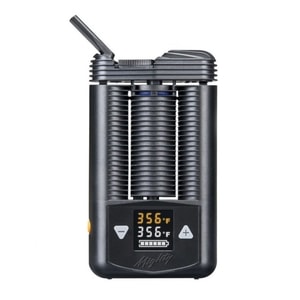 Based on the materials it’s made of, the MIGHTY doesn’t seem like the safest option when it comes to vaporizers…
Based on the materials it’s made of, the MIGHTY doesn’t seem like the safest option when it comes to vaporizers…
A large part of its vapor path is made of plastic. Heat-resistant and food-safe plastic…but it’s still plastic.
Therefore it might come as a surprise:
The MIGHTY is one of the safest portable, battery-powered vaporizers you can get.
Here’s why:
It’s the only portable vaporizer that is licensed and classified as a ‘medical device’ in three different parts of the world: Canada, Europe, and Israel. It’s also one of the few vaporizers that operate with a heating element that’s tested to check whether it off-gasses any micro-particles.
Important to mention is that the medical version of the MIGHTY is called the “MIGHTY Medic”. Except for a disposable mouthpiece, this is the same vaporizer as the regular “MIGHTY”. In the countries where the MIGHTY Medic is licensed and classified as a medical device, you may have an option to claim it as a medical expense.
#2 VapCap M (Portable)
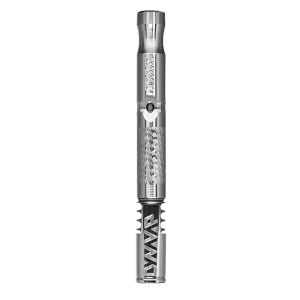 By now, you know that the heating element is the biggest potential health risk in a vaporizer.
By now, you know that the heating element is the biggest potential health risk in a vaporizer.
Well, the VapCap M eliminated that risk. It has no heating element.
The VapCap M is heated with a butane torch lighter. There’s absolutely no chance to inhale toxic fumes from an off-gassing heating element.
With the biggest risk gone, there’s only one risk left: the air- and vapor path.
The VapCap M is fully made of medical-grade stainless steel, so its air- and vapor path is completely safe as well.
#3 Volcano (Desktop)
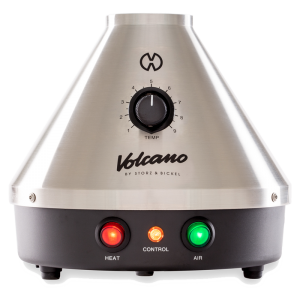 The Volcano Vaporizer is the oldest vaporizer and the most extensively tested vaporizer in the world.
The Volcano Vaporizer is the oldest vaporizer and the most extensively tested vaporizer in the world.
It comes from the same manufacturer as the MIGHTY: Storz and Bickel. And it comes with the same medical licenses and certifications as the MIGHTY (in the same countries).
Then there’s the fact that:
The majority of cannabis vapor-related studies are done with the Volcano Vaporizer. It’s the most used vaporizer in scientific tests. If there was anything even slightly concerning about this vaporizer, it would have long come out in the open…and nothing negative ever got published related to this vaporizer.
A Word About the Safety of E-Cigarettes and E-Liquids…
Several studies point towards the fact that e-cigarettes and e-liquids used in electronic cigarettes can be unhealthy for your health.
To stay safe if you’re an e-cigarette user, it’s important to read up on all the vaping health risks. Luckily, a lot of them are preventable with high-quality vaping gear and proper vaping techniques.
The bottom line is:
Electronic cigarettes and e-liquids are not always safe and I recommend doing your due diligence on the products you plan to use before you start vaping, by reading our ultimate guide on vaping health risks.
Final Words
You learned vaporizing is only healthier than smoking if you use a high-quality vaporizer.
What is a high-quality vaporizer?
Any vaporizer from a reputable brand that comes from an authorized dealer qualifies as proper, but we reviewed the best ones here for portable vaporizers and here for desktop vaporizers.
Some of you need extra assurance and want to absolutely minimize health risks. To understand how you can get this extra assurance, you learned what type of heating elements and air paths are the safest.
If you enjoyed this post and want more, follow us on Instagram or become a fan on Facebook and click share to look like the most intelligent guy/girl in your social circle.
Scientific References:
- Gieringer, D., St. Laurent, J., & Goodrich, S. (2004). Cannabis Vaporizer Combines Efficient Delivery of THC with Effective Suppression of Pyrolytic Compounds. Journal of Cannabis Therapeutics, 4(1), 7–27. https://doi.org/10.1300/j175v04n01_02
- Wani, A. L., Ara, A., & Usmani, J. A. (2015). Lead toxicity: a review. Interdisciplinary Toxicology, 8(2), 55–64. https://doi.org/10.1515/intox-2015-0009
- CRAPPER, D. R., KRISHNAN, S. S., & QUITTKAT, S. (1976). ALUMINIUM, NEUROFIBRILLARY DEGENERATION AND ALZHEIMER’S DISEASE. Brain, 99(1), 67–80. https://doi.org/10.1093/brain/99.1.67
- Storz & Bickel, Tretter, H., & Prott, U. (2009). VOLCANO DIGIT: Investigation of Aluminium Content in the Air Stream. UTM GmbH. Retrieved from https://www.vapormed.com/media/pdf/Heat%20Exchanger%20Alu%20Study.pdf
- Veríssimo, M. I., Oliveira, J. A., & Gomes, M. T. S. (2006). Leaching of aluminium from cooking pans and food containers. Sensors and Actuators B: Chemical, 118(1–2), 192–197. https://doi.org/10.1016/j.snb.2006.04.061
- Lindholst, C. (2010). Long term stability of cannabis resin and cannabis extracts. Australian Journal of Forensic Sciences, 42(3), 181–190. https://doi.org/10.1080/00450610903258144
- Krewski, D., Yokel, R. A., Nieboer, E., Borchelt, D., Cohen, J., Harry, J., . . . Rondeau, V. (2007). Human Health Risk Assessment for Aluminium, Aluminium Oxide, and Aluminium Hydroxide. Journal of Toxicology and Environmental Health, Part B, 10(sup1), 1–269. https://doi.org/10.1080/10937400701597766
- Rai, Prabhat. (2015). Multifaceted Health impacts of Particulate Matter (PM) and its management: An overview.. Environmental Skeptics & Critics. 4. https://www.researchgate.net/publication/274832105_Multifaceted_Health_impacts_of_Particulate_Matter_PM_and_its_management_An_overview
- Nagare, B., Marcolli, C., Stetzer, O., & Lohmann, U. (2015). Comparison of measured and calculated collision efficiencies at low temperatures. Atmospheric Chemistry and Physics, 15(23), 13759–13776. https://doi.org/10.5194/acp-15-13759-2015
- GLASS TECHNOLOGY SERVICES LTD. (2002). Investigation Of The Significant Factors In Elemental Migration From Glass In Contact With Food. Retrieved from https://www.glass-ts.com/userfiles/files/2002-09%20-%20FSA%20-%20A03029%20Final%20Report%20-%20Investigation%20of%20the%20Significant%20Factors%20in%20Elemental%20migration%20from%20Glass%20in%20Contact%20with%20Food.pdf
- Martins, C., Moreira, J., & Martins, J. (2014). Corrosion in water supply pipe stainless steel 304 and a supply line of helium in stainless steel 316. Engineering Failure Analysis, 39, 65–71. https://doi.org/10.1016/j.engfailanal.2014.01.017
- Kuligowski, J., & Halperin, K. M. (1992). Stainless steel cookware as a significant source of nickel, chromium, and iron. Archives of Environmental Contamination and Toxicology, 23(2), 211–215. https://doi.org/10.1007/bf00212277
- Wagoner, J. K. (1983). Toxicity of vinyl chloride and poly(vinyl chloride): a critical review. Environmental Health Perspectives, 52, 61–66. https://doi.org/10.1289/ehp.835261
- Halden, R. U. (2010). Plastics and Health Risks. Annual Review of Public Health, 31(1), 179–194. https://doi.org/10.1146/annurev.publhealth.012809.103714
